#websocket protocol
Explore tagged Tumblr posts
Text
Leveraging WebSocket Protocol for Dynamic Online Gaming Experiences
Experience the future of online gaming through the lens of WebSocket technology. Our infographic delves into the dynamic landscape of real-time gaming experiences, fueled by the efficiency and reliability of WebSocket connection.
#real time applications#client server communication#websocket connection#websocket protocol#network configuration#online gaming
0 notes
Text
What are web protocols?
What are #webprotocols? #networkdevices #websocket #protocol #webrtc
Web protocols are an important theme in enabling communication between devices on the internet. Web protocols are the secret handshakes in the digital world where the rules and conventions for data exchange are defined between the network devices. WebSocket They are a set of multiple standards where the WebSocket API is defined by the W3C, and the WebSocket protocol (RFC 6455) and its…
0 notes
Text
* These are simple games because I also want to flesh out single packet protocols and implement our first one GYGO (get your game on) which as you can probably ascertain is a single packet protocol for very simple games
28 notes
·
View notes
Text
Malicious PyPI packages abuse Gmail, websockets to hijack systems
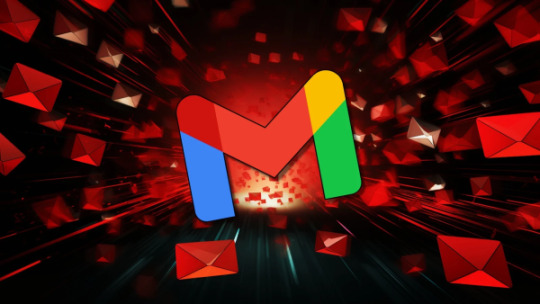
Source: https://www.bleepingcomputer.com/news/security/malicious-pypi-packages-abuse-gmail-websockets-to-hijack-systems/
More info: https://socket.dev/blog/using-trusted-protocols-against-you-gmail-as-a-c2-mechanism
3 notes
·
View notes
Text
Introduction to SkillonIT Learning Hub- Empowering Rural Talent With World-Class IT Skills
SkillonIT provides IN-Demand IT courses, connecting Rural talent with rewarding IT skills through affordable, accessible and career-focused education. with Guaranteed pathways to internship and high paying jobs, start with us and step into Opportunities at top Tech-leading Companies. Skillonit Learning Hub, located in Buldhana, Maharashtra, is a leading institute dedicated to equipping individuals with cutting-edge technology skills. With a mission to bridge the digital divide, the institute provides high-quality education in various IT and professional development domains. Skillonit focuses on practical, industry-oriented training, ensuring students gain the expertise needed to thrive in today’s competitive job market. The hub is committed to empowering rural talent and shaping the next generation of skilled professionals.

Courses Offered Skillonit Learning Hub offers a diverse range of courses tailored to industry demands, enabling students to master both technical and professional skills.
Blockchain Development — Smart Contracts (Solidity, Rust, Web3.js, Hardhat) — Blockchain Protocols (Ethereum, Solana, Binance Smart Chain, Fantom) — Decentralized Applications (DApps) Development
Front-End Development — HTML, CSS, JavaScript — Frameworks: React.js, Vue.js, Angular — Responsive Web Design & UI Frameworks (Bootstrap, Tailwind CSS)
Back-End Development — Server-side Programming (Node.js, Python, PHP, Java, .NET) — Database Management (MySQL, MongoDB, Firebase, PostgreSQL) — API Development (RESTful APIs, GraphQL, WebSockets)
Full-Stack Development — Front-End + Back-End Integration — MERN Stack Development — Database, Deployment & DevOps Practice
Mobile App Development — Cross-Platform Development (Flutter, React Native)
Unity 3D Game Development — Game Mechanics & Physics — C# Programming for Game Development — Virtual Reality (VR) & Augmented Reality (AR) Integration
Professional UI/UX Design — User Interface Design (Adobe XD, Figma, Sketch) — User Experience Principles — Prototyping, Wireframing & Usability Testing
Professional Graphic Design — Adobe Photoshop, Illustrator, and CorelDraw — Branding & Logo Design — Digital Art & Visual Communication
Digital Marketing — SEO, SEM, and Social Media Marketing — Content Marketing & Copywriting — Google Ads, Facebook Ads & Analytics
Spoken English — Communication Skills & Public Speaking — Accent Training & Fluency Improvement
Personality Development — Business & Corporate Etiquette — Confidence Building & Interview Preparation — Leadership & Teamwork Skills
Location & Contact : Address : Chhatrapati Tower, Above Maratha Mahila Urban, 3rd Floor, Chikhali Road, Buldhana, Maharashtra, 443001.
Contact us
Conclusion : Skillonit Learning Hub is revolutionizing IT and professional education by making technology and essential career skills accessible to aspiring developers, designers, marketers, and professionals. With a strong emphasis on practical learning, industry exposure, and career opportunities, it stands as a beacon of growth for young talent in Buldhana and beyond. Whether you are looking to build a career in tech, marketing, design, or personal development, Skillonit provides the ideal platform to achieve your goals. Join Our Social Community
Skillonit #Education #ITCourses #Buldhana #Maharashtra #IT #Blockchain #Fullstack #Front-end #Back-end #MobileApp #Unity3d #UIUX #Graphicdesign #Digitalmarketing #SpokenEnglish #Personality #development
2 notes
·
View notes
Text
Hey, Tumblr, I'm angry and frustrated and I'm making it your problem.

Break the Keep Reading only if you either A. have any experience with OBS-Websocket or other such integrations, or B. sincerely wish to partake in my suffering. Warning for excessive cursing, it gets rough.
Update on the whole KT-1632 overlay situation: After a handful of minor technical difficulties and rookie mistakes (hey cat, it would help if you actually turned on the damn websocket before trying to connect to it), I've established a base framework for connecting to OBS Websocket.
Once I had that in place, I started testing out what kind of messages I can get, and uh... I'm already running into a huge problem, here.
See, OBS Websocket 5.0 has the following messages that seem pertinent to my use case: CurrentProgramSceneChanged, SceneTransitionStarted, SceneTransitionEnded, and SceneTransitionVideoEnded. Keep in mind, the only documentation I can access right now, as far as I can tell, is just the 5.0.1 OBS-Websocket.
Here's a refresher on the use case: I want to be able to move elements of my Unity-based stream overlay depending on which scene is currently active in OBS. A wrinkle in this is that I use a custom stinger transition with a specific cut point, like this:
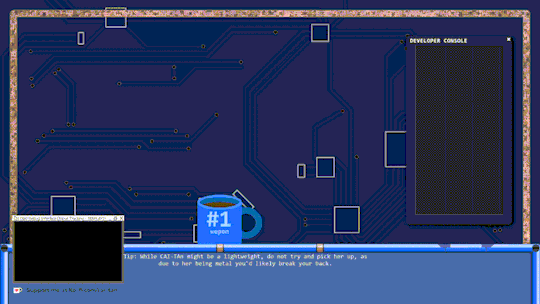
Now, all three events regarding the scene transition only have one piece of data to them: the name of the transition (which is basically always going to be "SniperScope"). The only event that actually tells me what scene is being switched to is the CurrentProgramSceneChanged event.
There is an immediate problem.

Funnily enough, this order of operations is actually backwards from the current documentation:
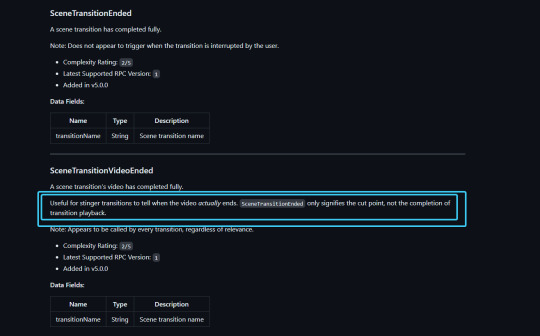
On the one hand, there could potentially be some sort of delay or other issue involved with WebsocketSharp / Unity that's responsible for this, however in my testing the exact amount of delay and order of operations is entirely consistent every single time I initiate a transition in OBS. The first message almost always arrives instantaneously; it's the other three messages that seem to come whenever they feel like it, and not at all close to what they need to be at.
On the other hand-- wait, what? What's this issue on the official obs-websocket github about--
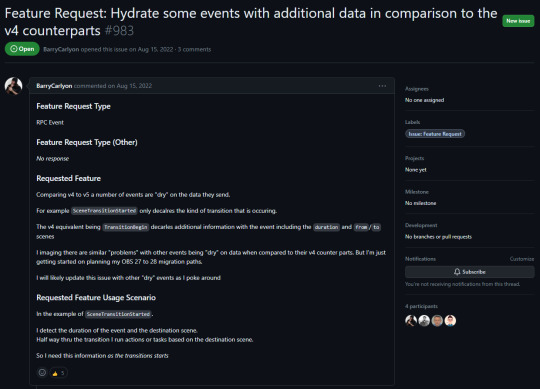
So you're telling me that SceneTransitionStarted used to have the from and to scenes specified in the event data in version 4, and they removed it in version 5 for literally no other reason than an RPC overhaul? And they haven't added it back in OVER A YEAR?!
Now, the github actually does have an install link for obs-websocket version 4.9.1-compat that should (keyword should, you know how that goes) work with OBS 29 (more specifically, it should work with 28+, which means there isn't even a guarantee for it to work with OBS 29... fucking awesome).
However, uhhhhhh... I cannot find ANY FUCKING DOCUMENTATION FOR 4.9'S PROTOCOL WHATSO-FUCKING-EVER. There is LITERALLY ONLY 5.0 in the readmes and protocol.md docs.
This shit has me pulling my hair. I'm goin' the fuck to sleep. Anyone got any bright fuckin ideas, I'm all fuckin' ears for it in the morning.
#pain and suffering#streaming#indie vtuber#software development#obs troubleshooting#obs studio#help appreciated#websocketsharp#obs websocket
3 notes
·
View notes
Text
Advanced Techniques in Full-Stack Development

Certainly, let's delve deeper into more advanced techniques and concepts in full-stack development:
1. Server-Side Rendering (SSR) and Static Site Generation (SSG):
SSR: Rendering web pages on the server side to improve performance and SEO by delivering fully rendered pages to the client.
SSG: Generating static HTML files at build time, enhancing speed, and reducing the server load.
2. WebAssembly:
WebAssembly (Wasm): A binary instruction format for a stack-based virtual machine. It allows high-performance execution of code on web browsers, enabling languages like C, C++, and Rust to run in web applications.
3. Progressive Web Apps (PWAs) Enhancements:
Background Sync: Allowing PWAs to sync data in the background even when the app is closed.
Web Push Notifications: Implementing push notifications to engage users even when they are not actively using the application.
4. State Management:
Redux and MobX: Advanced state management libraries in React applications for managing complex application states efficiently.
Reactive Programming: Utilizing RxJS or other reactive programming libraries to handle asynchronous data streams and events in real-time applications.
5. WebSockets and WebRTC:
WebSockets: Enabling real-time, bidirectional communication between clients and servers for applications requiring constant data updates.
WebRTC: Facilitating real-time communication, such as video chat, directly between web browsers without the need for plugins or additional software.
6. Caching Strategies:
Content Delivery Networks (CDN): Leveraging CDNs to cache and distribute content globally, improving website loading speeds for users worldwide.
Service Workers: Using service workers to cache assets and data, providing offline access and improving performance for returning visitors.
7. GraphQL Subscriptions:
GraphQL Subscriptions: Enabling real-time updates in GraphQL APIs by allowing clients to subscribe to specific events and receive push notifications when data changes.
8. Authentication and Authorization:
OAuth 2.0 and OpenID Connect: Implementing secure authentication and authorization protocols for user login and access control.
JSON Web Tokens (JWT): Utilizing JWTs to securely transmit information between parties, ensuring data integrity and authenticity.
9. Content Management Systems (CMS) Integration:
Headless CMS: Integrating headless CMS like Contentful or Strapi, allowing content creators to manage content independently from the application's front end.
10. Automated Performance Optimization:
Lighthouse and Web Vitals: Utilizing tools like Lighthouse and Google's Web Vitals to measure and optimize web performance, focusing on key user-centric metrics like loading speed and interactivity.
11. Machine Learning and AI Integration:
TensorFlow.js and ONNX.js: Integrating machine learning models directly into web applications for tasks like image recognition, language processing, and recommendation systems.
12. Cross-Platform Development with Electron:
Electron: Building cross-platform desktop applications using web technologies (HTML, CSS, JavaScript), allowing developers to create desktop apps for Windows, macOS, and Linux.
13. Advanced Database Techniques:
Database Sharding: Implementing database sharding techniques to distribute large databases across multiple servers, improving scalability and performance.
Full-Text Search and Indexing: Implementing full-text search capabilities and optimized indexing for efficient searching and data retrieval.
14. Chaos Engineering:
Chaos Engineering: Introducing controlled experiments to identify weaknesses and potential failures in the system, ensuring the application's resilience and reliability.
15. Serverless Architectures with AWS Lambda or Azure Functions:
Serverless Architectures: Building applications as a collection of small, single-purpose functions that run in a serverless environment, providing automatic scaling and cost efficiency.
16. Data Pipelines and ETL (Extract, Transform, Load) Processes:
Data Pipelines: Creating automated data pipelines for processing and transforming large volumes of data, integrating various data sources and ensuring data consistency.
17. Responsive Design and Accessibility:
Responsive Design: Implementing advanced responsive design techniques for seamless user experiences across a variety of devices and screen sizes.
Accessibility: Ensuring web applications are accessible to all users, including those with disabilities, by following WCAG guidelines and ARIA practices.
full stack development training in Pune
2 notes
·
View notes
Text
Revolutionize Your Trading with Alltick’s Ultra-Fast Market Data API
In the world of finance, speed is everything. A fraction of a second can mean the difference between a winning trade and a missed opportunity. While legacy data providers like Bloomberg Terminal and Reuters Eikon have dominated the market, their high costs and complex infrastructures make them inaccessible for many traders and firms.
Alltick’s Market Data API changes the game—delivering real-time, low-latency stock, forex, and crypto data at a fraction of the cost, without compromising on speed or reliability.
Why Alltick Beats Traditional Market Data Providers
✔ True Real-Time Feeds – No delays, no batch updates. Get tick-by-tick data with millisecond-level precision. ✔ Global Market Coverage – Seamless access to NYSE, NASDAQ, HKEX, LSE, Forex, and Crypto markets in one unified API. ✔ Built for High-Frequency Trading (HFT) – Optimized WebSocket & FIX protocols ensure ultra-low latency execution. ✔ Enterprise-Grade Infrastructure – 99.99% uptime with redundant data centers for uninterrupted trading. ✔ Developer-Friendly Integration – SDKs for Python, Java, C++, and C#, plus clean, well-documented APIs.
Who Needs Alltick’s Real-Time Market Data?
🔹 Quantitative & Algo Traders – Backtest and deploy strategies with real-time order book & tick data. 🔹 Fintech Startups & Robo-Advisors – Power your platform with institutional-grade data without the Bloomberg price tag. 🔹 Hedge Funds & Prop Firms – Gain an edge with ultra-fast execution & depth-of-market insights. 🔹 Retail Traders & Investors – Access professional-level data previously reserved for Wall Street elites.
Key Features That Set Alltick Apart
1. Lightning-Fast Data Delivery
WebSocket API – Stream live prices, trades, and order book updates in real time.
FIX Protocol – Ideal for automated trading systems requiring microsecond-level precision.
REST API – Retrieve historical data, snapshots, and fundamentals with ease.
2. Comprehensive Asset Coverage
Stocks & ETFs (US, EU, APAC markets)
Forex (Major, minor, and exotic pairs)
Cryptocurrencies (Spot & derivatives)
Options & Futures (Live pricing & volatility data)
3. Cost-Efficient Pricing
Unlike Bloomberg or Reuters, which charge thousands per month, Alltick offers scalable pricing suitable for:
Retail traders who need real-time data without the high costs.
Institutional firms looking to reduce data vendor expenses.
Fintech developers building next-gen trading platforms.
Upgrade from Legacy Data Providers
Why pay premium prices for outdated systems? Alltick delivers: ✅ Faster data than Bloomberg Terminal & Reuters Eikon ✅ More affordable than IQFeed & Interactive Brokers ✅ More flexible than traditional vendor lock-in solutions
Get Started Risk-Free
🚀 Try Alltick’s API for Free – Experience the power of real-time, low-latency market data today.
0 notes
Text
Beyond the Books: Real-World Coding Projects for Aspiring Developers
One of the best colleges in Jaipur, which is Arya College of Engineering & I.T. They transitioning from theoretical learning to hands-on coding is a crucial step in a computer science education. Real-world projects bridge this gap, enabling students to apply classroom concepts, build portfolios, and develop industry-ready skills. Here are impactful project ideas across various domains that every computer science student should consider:
Web Development
Personal Portfolio Website: Design and deploy a website to showcase your skills, projects, and resume. This project teaches HTML, CSS, JavaScript, and optionally frameworks like React or Bootstrap, and helps you understand web hosting and deployment.
E-Commerce Platform: Build a basic online store with product listings, shopping carts, and payment integration. This project introduces backend development, database management, and user authentication.
Mobile App Development
Recipe Finder App: Develop a mobile app that lets users search for recipes based on ingredients they have. This project covers UI/UX design, API integration, and mobile programming languages like Java (Android) or Swift (iOS).
Personal Finance Tracker: Create an app to help users manage expenses, budgets, and savings, integrating features like OCR for receipt scanning.
Data Science and Analytics
Social Media Trends Analysis Tool: Analyze data from platforms like Twitter or Instagram to identify trends and visualize user behavior. This project involves data scraping, natural language processing, and data visualization.
Stock Market Prediction Tool: Use historical stock data and machine learning algorithms to predict future trends, applying regression, classification, and data visualization techniques.
Artificial Intelligence and Machine Learning
Face Detection System: Implement a system that recognizes faces in images or video streams using OpenCV and Python. This project explores computer vision and deep learning.
Spam Filtering: Build a model to classify messages as spam or not using natural language processing and machine learning.
Cybersecurity
Virtual Private Network (VPN): Develop a simple VPN to understand network protocols and encryption. This project enhances your knowledge of cybersecurity fundamentals and system administration.
Intrusion Detection System (IDS): Create a tool to monitor network traffic and detect suspicious activities, requiring network programming and data analysis skills.
Collaborative and Cloud-Based Applications
Real-Time Collaborative Code Editor: Build a web-based editor where multiple users can code together in real time, using technologies like WebSocket, React, Node.js, and MongoDB. This project demonstrates real-time synchronization and operational transformation.
IoT and Automation
Smart Home Automation System: Design a system to control home devices (lights, thermostats, cameras) remotely, integrating hardware, software, and cloud services.
Attendance System with Facial Recognition: Automate attendance tracking using facial recognition and deploy it with hardware like Raspberry Pi.
Other Noteworthy Projects
Chatbots: Develop conversational agents for customer support or entertainment, leveraging natural language processing and AI.
Weather Forecasting App: Create a user-friendly app displaying real-time weather data and forecasts, using APIs and data visualization.
Game Development: Build a simple 2D or 3D game using Unity or Unreal Engine to combine programming with creativity.
Tips for Maximizing Project Impact
Align With Interests: Choose projects that resonate with your career goals or personal passions for sustained motivation.
Emphasize Teamwork: Collaborate with peers to enhance communication and project management skills.
Focus on Real-World Problems: Address genuine challenges to make your projects more relevant and impressive to employers.
Document and Present: Maintain clear documentation and present your work effectively to demonstrate professionalism and technical depth.
Conclusion
Engaging in real-world projects is the cornerstone of a robust computer science education. These experiences not only reinforce theoretical knowledge but also cultivate practical abilities, creativity, and confidence, preparing students for the demands of the tech industry.
0 notes
Text
MEV Bot Development: A Step-by-Step Guide

Introduction
As the DeFi ecosystem grows more complex, MEV (Maximal Extractable Value) bots have become one of the most powerful—and controversial—tools in crypto trading. These bots are designed to extract value from blockchain transactions by reordering, inserting, or censoring transactions in a block. While originally focused on miners, today’s MEV bot development company opportunities are accessible to smart developers who can build bots to interact with protocols like Uniswap, SushiSwap, Curve, and others.
In this step-by-step guide, we’ll walk through the process of developing your own MEV bot—from understanding its core components to writing, simulating, and deploying it.
What Is an MEV Bot?
An MEV bot is an automated trading agent that exploits inefficiencies in blockchain transactions. It aims to maximize profit through techniques such as:
Arbitrage: Buying an asset at a lower price on one DEX and selling it higher on another.
Sandwich Attacks: Placing a buy order before and a sell order after a large user transaction to manipulate price movements.
Liquidation Sniping: Monitoring DeFi lending protocols for vulnerable positions and profiting from liquidations.
These bots monitor the mempool or integrate with services like Flashbots to submit private bundles directly to miners or validators.
MEV Bot Development: A Step-by-Step Guide
Step 1: Understand MEV Fundamentals
Start by learning what Maximal Extractable Value (MEV) means, how it impacts Ethereum and other blockchains, and the types of MEV strategies such as arbitrage, sandwich attacks, and liquidations. Understanding blockchain mechanics, mempool structure, transaction ordering, and frontrunning concepts is critical before development.
Step 2: Choose Your MEV Strategy
Select the specific MEV technique you want to implement—DEX arbitrage, sandwiching, liquidation sniping, or time-bandit attacks. Your choice will determine the logic and external data your bot will need to operate effectively.
Step 3: Set Up Your Development Environment
Install essential tools like Node.js, Hardhat or Foundry, ethers.js or web3.js, and connect to Ethereum mainnet via Infura or Alchemy. Set up Flashbots for private transaction bundling. Use Git and VSCode for development and version control.
Step 4: Monitor Blockchain Data and Mempool
Develop or use an existing script to monitor pending transactions in the mempool using WebSocket or JSON-RPC. For strategies like sandwich or liquidation attacks, listen for large swaps or vulnerable loans, and simulate how your bot should respond.
Step 5: Write the Bot Logic
Create the logic for transaction construction, execution flow, and profit calculation. Include logic for gas estimation, token approvals, smart contract calls, and condition-based execution. Integrate error handling and fallback mechanisms.
Step 6: Simulate and Test on a Forked Network
Use Hardhat or Foundry to fork mainnet and simulate your bot’s transactions in a safe environment. Test for profitability, failed conditions, slippage, and gas efficiency. Refine strategy logic based on simulation results.
Step 7: Integrate Flashbots for Private Execution
To avoid frontrunning and reduce failed transactions, integrate with Flashbots by creating and submitting bundles directly to miners or validators. This helps ensure your transactions are mined in the intended order.
Step 8: Deploy the Bot on Mainnet
Once tested, deploy the bot on the Ethereum mainnet or another supported network. Run it on a secure server or cloud platform. Use cron jobs or real-time triggers to keep the bot active and responsive.
Step 9: Monitor and Optimize Performance
Track your bot’s trade history, gas usage, and success rate. Use dashboards or logging tools for performance monitoring. Continuously optimize strategies by adapting to network changes, gas spikes, and competition from other bots.
Step 10: Stay Updated and Compliant
The MEV landscape evolves quickly. Stay informed through forums, GitHub, and Flashbots research. Monitor ethical debates and legal implications around MEV activities. Consider evolving your bot for multi-chain or L2 MEV opportunities.
What Makes MEV Bots Different from Regular Crypto Bots?
MEV bots differ from regular crypto trading bots in that they extract profits by manipulating the order and timing of on-chain transactions, rather than relying on market trends or exchange arbitrage. While regular bots operate through APIs or smart contracts to execute predefined strategies like scalping or grid trading, MEV bots actively monitor the blockchain’s mempool to exploit inefficiencies such as frontrunning, sandwich attacks, and liquidations. They often use private relayers like Flashbots to submit transaction bundles directly to validators, enabling faster and more secure execution. This makes MEV bots more complex, time-sensitive, and ethically debated compared to traditional trading bots.
Conclusion
A MEV bot development can be highly profitable—but it’s also complex, competitive, and ethically gray. With the right technical knowledge, tools, and strategic insights, developers can enter the world of MEV extraction and participate in the most cutting-edge space in DeFi.
Whether you're building a simple arbitrage bot or a sophisticated front-runner, understanding the Ethereum transaction stack and using Flashbots responsibly is key to long-term success.
0 notes
Text
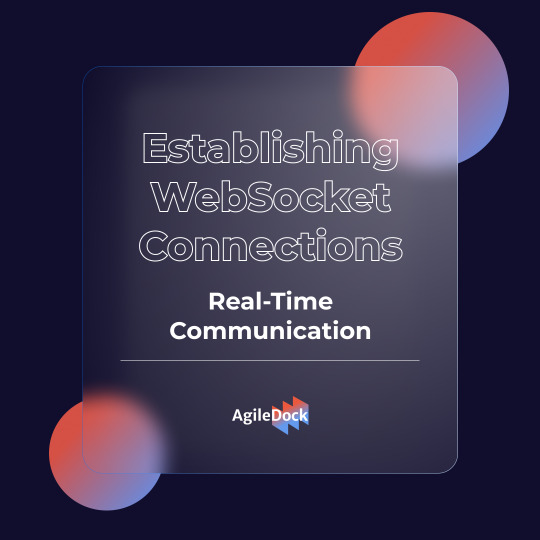
Harnessing Websockets for Real-Time Efficiency
Get an understanding of real-time applications by harnessing the potential of WebSockets. See how Websockets are driving efficiency and interactivity in online gaming and beyond.
#real time applications#client server communication#websocket connection#websocket protocol#network configuration#online gaming
0 notes
Text
What is WebRTC (Real-Time Peer-to-Peer Communication)?

In a world that thrives on real-time digital communication, WebRTC (Web Real-Time Communication) has emerged as one of the most innovative technologies, enabling seamless peer-to-peer communication directly in web browsers. Whether you’re making a video call, joining a conference meeting, or chatting live on a support portal, chances are you’re benefiting from WebRTC’s powerful capabilities — often without even realizing it.
Understanding WebRTC
WebRTC is an open-source project developed by Google that allows direct peer-to-peer communication via audio, video, and data sharing without the need for plugins or third-party software. It is built into most modern browsers, including Chrome, Firefox, Safari, and Edge, making it easily accessible to developers and users alike.
The primary goal of WebRTC is to establish real-time, low-latency connections between users. This is achieved using a set of standardized APIs that allow devices to discover one another, negotiate communication parameters, and exchange encrypted data streams — all within the browser.
How WebRTC Works
To appreciate the power of WebRTC, it’s helpful to understand the basic flow of how it works:
Signaling: Before a connection is established, WebRTC needs a signaling mechanism (not defined by WebRTC itself) to exchange metadata like network information and media capabilities. This is usually done through WebSocket or HTTP.
ICE Framework: WebRTC uses ICE (Interactive Connectivity Establishment) to discover the best path between devices by testing a series of connection candidates.
STUN/TURN Servers: These servers help navigate NATs (Network Address Translators) and firewalls. STUN servers find the public IP address, while TURN servers relay data if a direct connection can’t be established.
Media and Data Channels: Once the connection is made, WebRTC enables the real-time exchange of media (audio/video) or generic data through secure channels.
Key Features of WebRTC
Plugin-Free Communication: Unlike traditional VoIP or video services, WebRTC does not require any software installation or browser plugins.
Cross-Platform Compatibility: Works on all major desktop and mobile browsers.
Security: Encrypted media and data using DTLS and SRTP protocols.
Low Latency: Ensures real-time communication suitable for video conferencing, gaming, or live support.
Data Channels: Beyond voice and video, WebRTC allows the exchange of files or text data securely.
WebRTC Use Cases
1. Video Conferencing
Services like Google Meet and Facebook Messenger use WebRTC to provide smooth video calling experiences. It supports group calls, screen sharing, and adaptive streaming.
2. Customer Support Chat
Many businesses integrate WebRTC to enable real-time chat and call support directly within their websites — no downloads required.
3. Telehealth Services
Doctors can securely consult patients using video calls facilitated by WebRTC, helping extend healthcare access remotely.
4. Online Gaming and Collaboration Tools
Real-time voice chat and data sharing enhance the gaming experience, while collaboration tools like whiteboards and co-editing apps use WebRTC to maintain instant updates.
5. Affordable International Calling
Companies leveraging WebRTC can offer competitive calling services. For example, they enable users who are Ready to Make Affordable International Calls right from a browser window, bypassing traditional telecom infrastructure.
Why WebRTC Matters in Today’s Digital World
The global shift to remote work, online learning, and virtual socializing has amplified the need for reliable, real-time communication. Traditional systems like PSTN (Public Switched Telephone Network) or even some VoIP protocols often involve complex setups or subscription models. WebRTC breaks down those barriers by being free, efficient, and developer-friendly.
Furthermore, by enabling international calling directly from browser, WebRTC removes the friction often associated with downloading software or using hardware-based phones. This is especially advantageous for people in regions with limited access to traditional telephony or for companies looking to serve global audiences efficiently.
WebRTC and the Telecom Industry
The telecom landscape is evolving. Once dominated by landlines and cellular services, the focus is shifting toward digital-first solutions. WebRTC plays a crucial role in this transformation, allowing providers to offer more flexible and cost-effective communication services.
For example, users can now Call landlines and mobiles anywhere in the world through web-based platforms powered by WebRTC. This innovation not only simplifies international communication but also drastically reduces the associated costs.
Startups and enterprises alike are incorporating WebRTC into their offerings to disrupt traditional calling plans. By doing so, they empower individuals and businesses to be Ready to Make Affordable International Calls — whether for personal use, customer support, or business meetings.
Challenges and Limitations
While WebRTC is powerful, it’s not without challenges:
Browser Compatibility: Although support is widespread, there are still minor differences in how browsers implement WebRTC.
Network Reliability: Performance can be affected by poor internet connections, especially during high-bandwidth activities like HD video calls.
Scalability: Peer-to-peer connections are optimal for small groups. For large-scale broadcasts, you need additional infrastructure like SFUs (Selective Forwarding Units).
Security and Privacy: Even though WebRTC uses strong encryption, developers must still follow best practices to ensure user data is protected.
Future of WebRTC
As the demand for real-time communication grows, so will the capabilities of WebRTC. New updates aim to improve codec efficiency, integrate with machine learning tools (e.g., for noise suppression or auto-captioning), and enhance support for multi-party calls.
With the increasing integration of 5G and edge computing, WebRTC is poised to deliver even more responsive and immersive communication experiences across devices and platforms.
WebRTC represents a paradigm shift in how we communicate online. From casual video chats to enterprise-grade conferencing systems, it enables efficient, scalable, and secure real-time communication across the web. Whether you’re looking to chat face-to-face, collaborate on projects, or are Ready to Make Affordable International Calls, WebRTC is the technology powering these seamless experiences.
As digital transformation continues to unfold across industries, WebRTC will remain a foundational element, enabling users to Call landlines and mobiles anywhere in the world with just a click — no downloads, no delays, just real-time connection.
#WebRTC#Peer to peer communication#international call#communication#internet communication#web technology#Calls#5G#browser#pc call
0 notes
Note
For PierMesh, how would you envision something like file sharing/hosting working? Would it be like how it is now, with someone setting up some dedicated host and others being able to access/replicate it like current file sharing server/torrenting setups?
Sorry I just saw this!
So small file sharing directly over PierMesh will be delivered directly to the recipient on the backend with LoRa and the frontend with Websockets with the caveat that it does have to pass through a node physically. We already have a peer to peer protocol called Bubble which will handle this and I'm working on e2ee at the moment so data can be securely shared. As an intermediate step for larger files though we'll also have a way to do peer to peer sharing over the current main internet.
Addition: for the scenario that someone wants to advertise a file for download (like serving it in traditional architecture) in some way that will need to be implemented but is trivial given the architecture of PierMesh.
5 notes
·
View notes
Text
Breaking Barriers in Software Quality: Advanced API Testing Services for Modern Architectures

In the dynamic landscape of software engineering, application performance, scalability, and reliability have become non-negotiables. With the shift from monolithic architectures to microservices, and the explosion of interconnected systems, APIs are now the backbone of modern digital ecosystems. As APIs grow in complexity and ubiquity, so too must the strategies used to test them.
At Robotico Digital, we understand that software quality hinges on much more than clean UI and functional frontends. It’s about what lies beneath — how systems interact, how services communicate, and how fast and securely data flows between components. This is where our API Testing Services break barriers, ensuring quality at the very core of your application stack.
Understanding API Testing in the Context of Modern Architectures
API Testing refers to the process of validating application programming interfaces (APIs) directly at the message layer, without the use of a GUI. It verifies that APIs return correct responses, handle errors appropriately, and meet performance and security expectations.
In microservices, APIs are the only communication mechanism between services. In serverless computing, APIs trigger the logic. And in mobile-first or headless applications, APIs drive every interaction.
Thus, API Testing Services today must adapt to modern environments by:
l Supporting asynchronous data flow and event-driven models.
l Validating REST, SOAP, GraphQL, gRPC, and WebSocket protocols.
l Integrating with CI/CD pipelines and DevOps tools for rapid iteration.
Why Traditional Testing Fails Modern Architectures
Legacy testing models often fall short because:
l They rely heavily on UI testing, which isn’t scalable or robust.
l They fail to isolate service-level issues in microservice deployments.
l They lack integration with agile development and DevOps cycles.
At Robotico Digital, we address these challenges with a future-ready API-first testing strategy that enables rapid development and secure, stable deployments.
Robotico Digital's Advanced API Testing Services: A Framework of Excellence
Our API Testing Services are structured around an advanced framework tailored for high-speed development environments, featuring:
1. Protocol-Agnostic Testing Architecture
Our test harness supports:
l REST, SOAP, GraphQL, gRPC, WebSocket, and JSON-RPC
l OAuth, JWT, and API Key-based authentication
l Complex nested payloads and chained request workflows
We don’t just send requests and verify status codes — we simulate real-world behavior.
2. Contract Testing with Swagger and OpenAPI
We validate API contracts using:
l Swagger and Postman schema validations
l Pact-based consumer-driven testing
l Automated schema diff tools
This ensures API consistency across development teams, especially in environments with multiple consumer applications.
3. Comprehensive Functional and Regression Suites
Our functional testing stack includes:
l Request/response validation with parameterized payloads
l Chaining dependent API calls to simulate real transactions
l Edge-case testing for malformed requests and injection handling
These suites form the backbone of our regression testing strategy, ensuring every build remains stable without code breaks.
Seamless Integration with DevOps Pipelines
In a CI/CD world, testing must be continuous. Robotico Digital provides seamless API Testing Service integration with:
l Jenkins, GitHub Actions, GitLab CI, Azure DevOps
l Dockerized test runners for isolated test environments
l Slack and Teams integrations for alerting and test reports
Tests are triggered automatically on code commits or builds, reducing human intervention and increasing speed.
API Test Automation: Scaling Quality at Speed
Automation is key to modern testing strategies. Robotico Digital leverages:
l Postman + Newman for exploratory and lightweight test execution
l REST Assured + TestNG for Java-based enterprise-grade test suites
l Cypress and Supertest for JavaScript and Node.js applications
l Karate DSL for end-to-end BDD-driven API Testing
We use data-driven test design and test parallelism to achieve high throughput and full API coverage — even across large microservices ecosystems.
Intelligent Test Data Management (TDM)
Test data is critical, especially when APIs depend on complex backend states. Our TDM solutions provide:
l Synthetic test data generation using Faker and Mockaroo
l Encrypted data masking for secure production cloning
l Environment-specific data pools to avoid cross-test pollution
This empowers our teams to run API tests with production-like reliability in test environments.
Performance & Load Testing of APIs
APIs underperforming in production can lead to latency, downtime, and failed transactions. Robotico Digital performs rigorous API performance testing, including:
Load Simulation with tools like JMeter, Gatling, and Locust
l Spike, soak, and stress testing to evaluate limits
l Latency monitoring across geographies
l Response time threshold validations
Our tests replicate thousands of concurrent requests, ensuring your APIs hold up under real-world traffic scenarios.
API Security Testing: Guarding the Gateway
Since APIs often expose business logic and sensitive data, security testing is non-negotiable. Robotico Digital incorporates security scanning into API Testing Services by:
l Validating for OWASP API Top 10 vulnerabilities
l Testing for broken authentication, excessive data exposure, rate limiting, and injection attacks
l Integrating Burp Suite, OWASP ZAP, and custom security probes into test pipelines
We don’t just test functionality — we test for resilience against malicious attacks.
Real-Time Reporting and Analytics
Transparency is critical. Our reporting dashboard includes:
l Detailed test summaries with pass/fail ratios
l Latency graphs and time-to-first-byte analysis
l Defect tracking with Jira, Azure Boards, or custom integrations
l REST APIs to extract test data into BI tools or custom reports
Clients always have clear visibility into the testing progress and quality metrics.
Future-Forward Testing with AI & ML
Robotico Digital is investing in the next generation of API Testing with:
l AI-based anomaly detection using test execution logs
l Predictive analytics to identify flaky endpoints
l Self-healing scripts that auto-adjust to changes in API structures
l NLP-driven test generation for conversational interfaces and AI-driven apps
These features ensure our API Testing Services evolve alongside tomorrow’s tech stacks.
Why Choose Robotico Digital for API Testing Services?
Here’s what sets us apart:
l Protocol-flexible architecture for REST, GraphQL, gRPC & more
l Intelligent automation backed by AI and ML
l Deep integration of performance and security testing
l CI/CD-native workflows built for speed
l Real-time test reporting and analytics dashboards
l Domain expertise across finance, healthcare, retail, SaaS, and telecom
We don’t just validate APIs — we engineer confidence into your ecosystem.
Conclusion: Quality at the Core of Connectivity
As businesses increasingly rely on interconnected software and modular architectures, API quality is business quality. At Robotico Digital, we’re pushing the boundaries of what's possible with API Testing Services — from functional validations and performance simulations to proactive security and predictive analytics.
If you're building for scale, agility, and resilience, let Robotico Digital be your QA partner. We ensure every interaction your users experience is powered by secure, fast, and flawless APIs.
0 notes
Text
WebSocket Integration with Node.js: Complete Guide
1. Introduction 1.1 What is WebSocket Integration with Node.js? WebSocket Integration with Node.js refers to the process of implementing real-time communication between a client (usually a web browser) and a server using the WebSocket protocol. Unlike traditional HTTP, which is request-response based, WebSockets provide a persistent, bi-directional communication channel, allowing both the…
0 notes
Text
Alltick API: Real-Time Data Solutions from Quantitative Trading Primer to Professional Strategies
Why You Need to Eliminate 15-Minute Delayed Market Data?
In fast-paced financial markets, a 15-minute data delay can mean massive opportunity costs. While retail investors rely on outdated prices to formulate strategies, institutional traders have already executed multiple trades using real-time data. This information asymmetry exists not only in stock markets but also in forex, futures, and cryptocurrencies—delayed data essentially provides historical, not actionable insights for live trading.
Alltick API’s Competitive Edge
1. Millisecond-Level Real-Time Global Coverage
Unlike traditional minute-delayed feeds, Alltick API delivers:
Equities: Real-time quotes from 50+ exchanges (NYSE, Nasdaq, HKEX, etc.)
Crypto: Full-coverage pricing from Binance, Coinbase, and other top platforms
Forex & Futures: CME/ICE derivatives market depth data
Unique Tick-Level Streams: Granular order-by-order execution records
2. Quant-Optimized Infrastructure
Architected for algorithmic trading:
99.99% Uptime SLA with 24/7 monitoring
Smart Bandwidth Compression for cost-efficient high-frequency data
Dynamic Load Balancing for scalable request handling
Unified Historical + Real-Time APIs for seamless backtesting
3. Frictionless Developer Experience
Designed for quant newcomers and pros alike:
Multi-Language SDKs (Python/Java/C++)
Plug-and-Play Code Templates
Interactive API Debug Console
Comprehensive English/Chinese Documentation
7×12 Technical Support via Slack & Email
Real-World Use Cases
Case 1: Rapid Strategy Validation
Case 2: Cross-Market Arbitrage Monitoring
Multi-Asset Capabilities Enable:
Stock vs ETF price divergence alerts
Crypto cross-exchange arbitrage detection
Forex spot-futures basis analysis
Case 3: HFT System Deployment
Institutional-Grade Features:
Co-located server hosting
Custom binary protocols
Microsecond-precision timestamps
Order flow analytics toolkit
Choosing Your API Tier
FeatureFree FeedsLegacy VendorsAlltick ProLatency15+ minutes1-5 seconds<100msHistorical DepthEOD Only1 Year10+ YearsConcurrent ConnectionsSingle Thread10-50UnlimitedData FieldsBasic OHLCStandardImplied Volatility, GreeksSupportNoneEmail (Weekdays)Dedicated Engineer
Start Your Quant Journey Today
Whether You Are:
A developer building your first SMA strategy
A quant team stress-testing models
An institution managing multi-strategy portfolios
Alltick offers tailored solutions from free trials to enterprise-grade deployments. Sign Up Now to Get: ✅ 30-Day Full-Feature Trial ✅ Exclusive Quant Strategy Playbook ✅ $500 Cloud Computing Credits
Visit Alltick Official Site to Experience Market Pulse in Real Time. Transform Every Decision with Data That Beats the Speed of Markets.
(CTA: Click "Developer Hub" to configure SDK in 5 mins and claim your API key.)
Technical Highlights
WebSocket/ REST API Hybrid Architecture: Balance speed with flexibility
Regulatory-Compliant Data: FINRA/SEC-reviewed market feeds
Zero Data Gaps: Guaranteed 100% tick reconstruction accuracy
Smart Retry Mechanisms: Auto-reconnect during network instability
Why 2,300+ Hedge Funds Choose Alltick? *"Alltick's unified API eliminated our multi-vendor integration headaches. We achieved 37% faster strategy iteration cycles."* — Head of Quant Trading, Top 50 Crypto Fund
Upgrade Your Edge. Trade at the Speed of Now.

1 note
·
View note